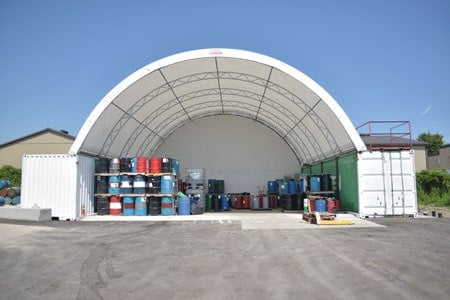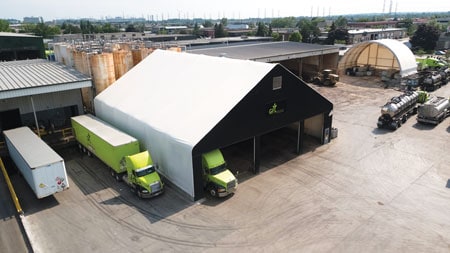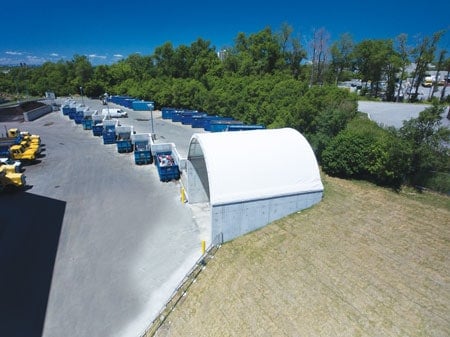A site evaluation ensures that the appropriate parameters are used for the analysis of the structure. The configuration of the building is thereby validated, or changes are made to ensure the structure has the requisite reliability for the site.
By Allan Ball
It is critical to ensure you receive the most efficient and reliable fabric structure possible when considering a structure for the waste and recycling industry due to its corrosive, low to medium-hazard nature.

Reputable fabric structure companies will work with their network of sales teams or dealers to obtain site photos with the orientation and location of the marked building. The advent of universally available satellite and street level imagery has allowed more detailed and accurate reviews of building sites. The site topography can be quickly reviewed to aid in determining exposure as well as identify other considerations such as wind channeling. This allows the fabric structure’s engineers to begin the process of evaluating the site conditions, which often involves conversation with the sales team or dealer, as well as the customer, before the engineers can finalize its site analysis.
Site Conditions
While there are substantial differences between building codes in various jurisdictions, evaluation of site conditions is broadly similar. A few key effects must be determined: snow, wind and seismic.
Both snow and wind effects are impacted by surrounding terrain and structures. For example, engineers will often require heights of adjacent structures if applicable. In practice it is sometimes difficult to make a clear distinction between roofs that will be fully exposed to winds and those that will not. The designer should, in consultation with the owner, weigh the probability of the roof becoming sheltered by an adjacent, taller building, adjacent, taller trees, or by an addition to the building itself. Such changes could cause either snow drift loads or higher average snow loads.
In considering drift loads, even the characteristics of the upwind obstructions are considered in many cases. For example, deciduous trees versus evergreen trees, tree species and average tree heights all play a role into the upwind obstructions considered. Wind effects in built-up urban environments require detailed review by experienced engineers to ensure they are correctly evaluated.
Seismic loading is also considered for all locations. Seismic loading can be a controlling load condition, particularly on the west coast. The seismic loading parameters are defined in the governing building code for the site.

Building Enclosure
The enclosure of a building should also be considered. Open-ended structures, fully-closed structures or partially-closed structures all play a significant role in the demand on the structure. The customer’s application for the structure will determine which configuration is needed. For example, a bulk storage application will often use a one-ended structure with the open end facing away from the prevailing weather. This configuration provides unrestricted access to load and unload the bulk commodity from the building while protecting it from most precipitation.
Building Usage
Lastly, the use of the building must also be considered for validation of the design. Buildings in low-hazard applications such as bulk-storage of salt are not required to have the same reliability as buildings that are occupied by people. Careful review of the building usage is needed to ensure that the correct application-related parameters are selected for the design. For example, a fabric structure located in a mountainous region occupied by several people may require more truss sections and bracing cables than an unoccupied fabric structure located in flat or open terrain.
Use the Experts
The entire process of a site-specific review can be quite involved and should not be left to anybody but the most experienced engineer professionals. A fabric structure company should use external, third-party engineers to review all structures to avoid company bias and ensure the strict objectivity of the design work. Site-specific reviews for standard configurations are completed within one to two weeks. If the review identifies that changes are required, these are discussed with the customer before the drawings are finalized. The customer is then supplied with stamped drawings for their structure.

The Appropriate Parameters
In conclusion, the outcome of the evaluation is the selection of appropriate design parameters per the relevant building code that defines the load cases that must be evaluated for the structure. The site evaluation ensures that the appropriate parameters are used for the analysis of the structure. The configuration of the building is thereby validated, or changes are made to ensure the structure has the requisite reliability for the site. This, along with snow loads, wind speeds and seismic parameters are considered as part of a detailed review for every site. | WA
Allan Ball, M.ASc., P.Eng. – Engineering Manager for Calhoun Super Structure (Tara, ON). Allan has two decades of engineering experience and a Master’s degree in Mechanical Engineering. Having been with Calhoun since 2011, he manages the team responsible for building design and analysis, offering technical expertise and input.
For more information, contact Deanna Hope, Marketing Manager for Calhoun Super Structure, at (519) 934-3037 or e-mail [email protected].
